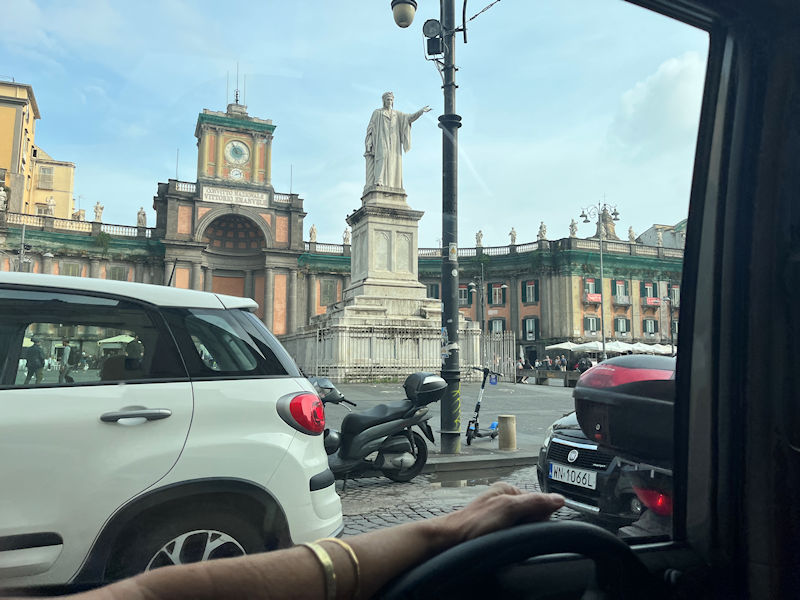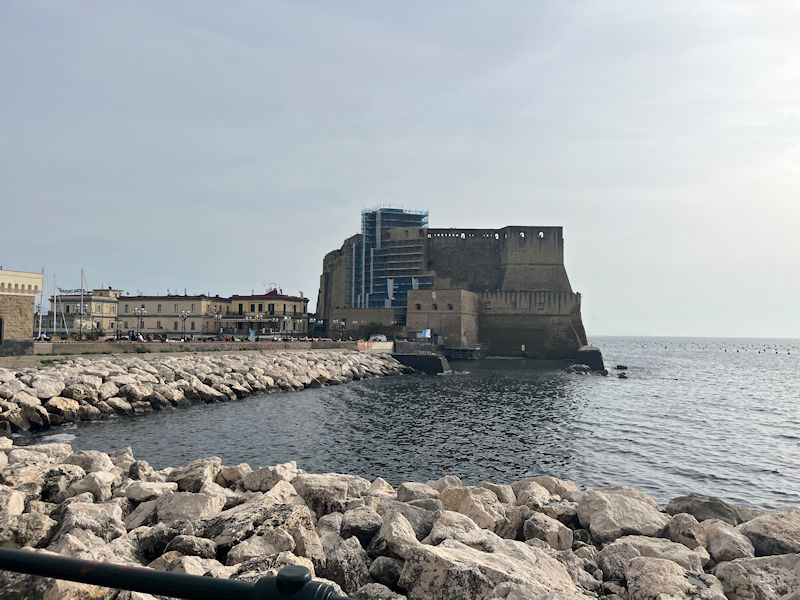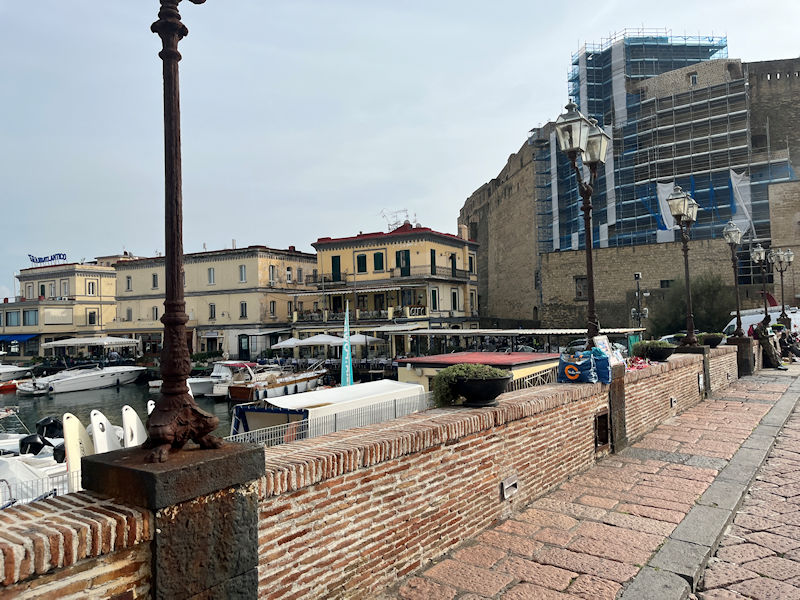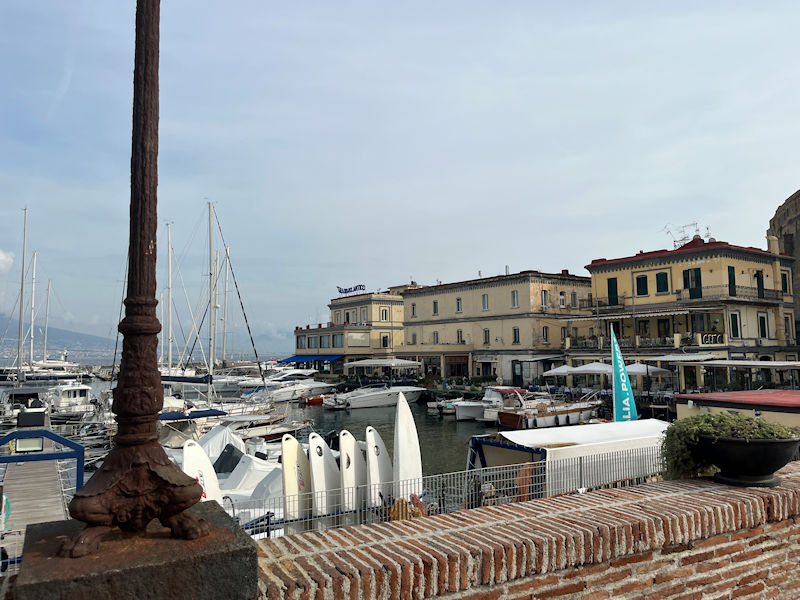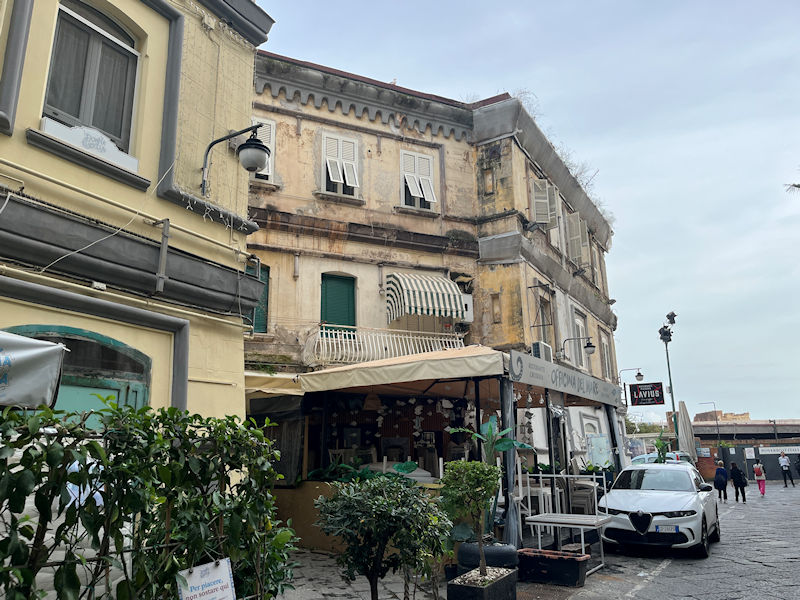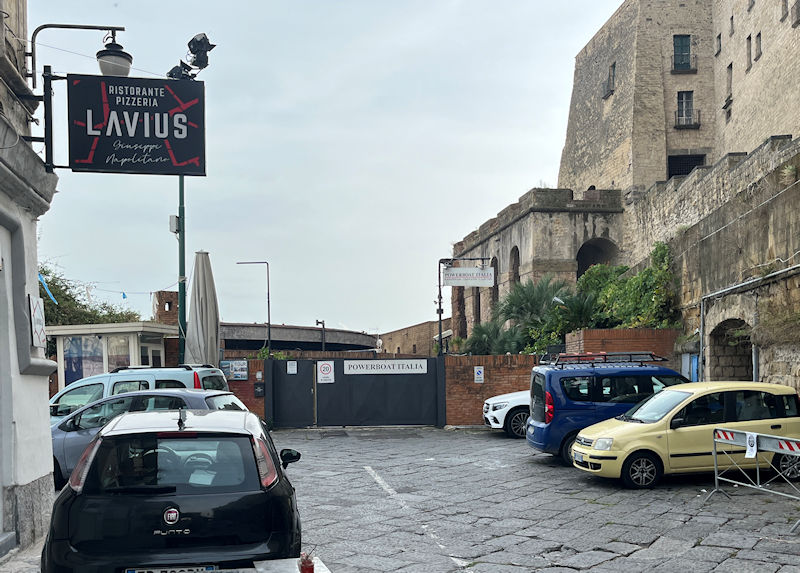You may not find this terribly rewarding unless you're included here, so this is a good time for casual and random browsers to turn back before they get too caught up in the sweep and majesty of the proceedings and can't let go.
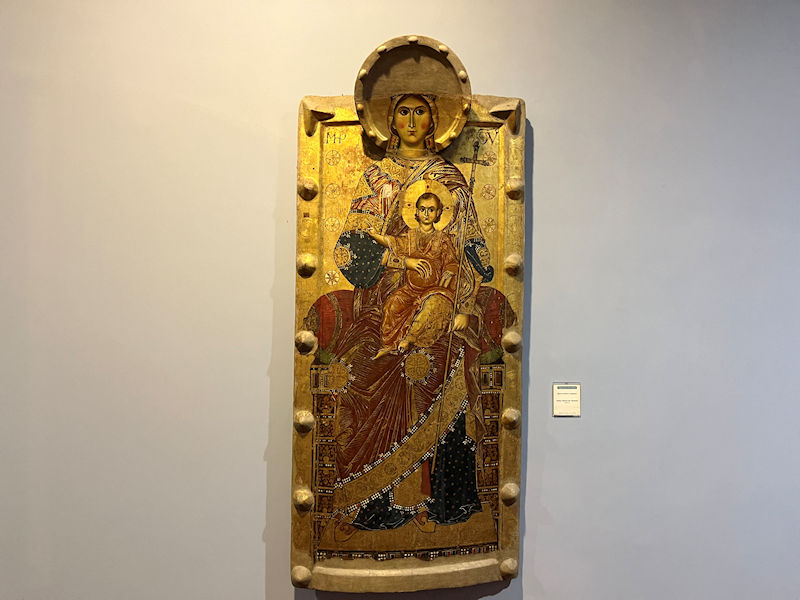
We're in another wing and starting chronologically back at the beginnings. This is 'Santa Maria de Flumine' (by the River), by an Unknown Painter of Campania, c.1290.

Head of the Virgin and of the Bambino, c.1280 (Unknown Painter of Campania)
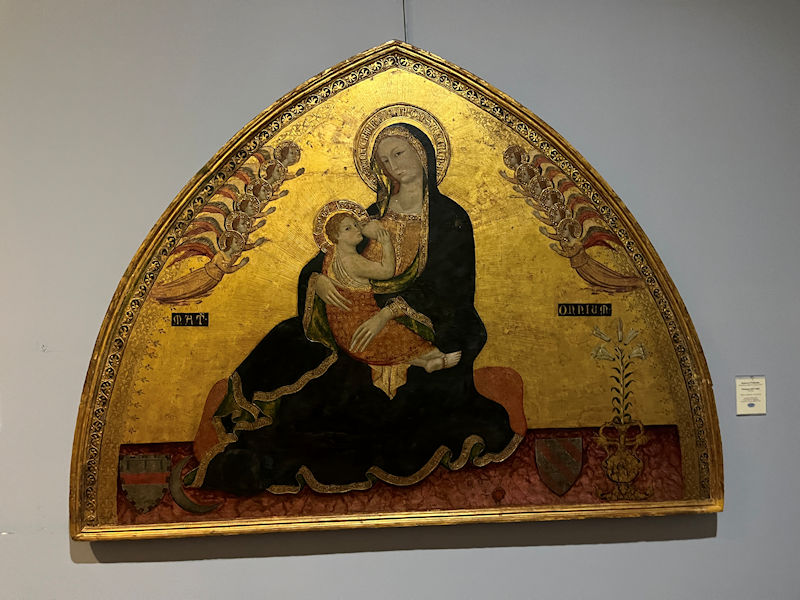
The 'Madonna of Humility', by Roberto d'Oderisio, 'active in Naples c.1330-1382'
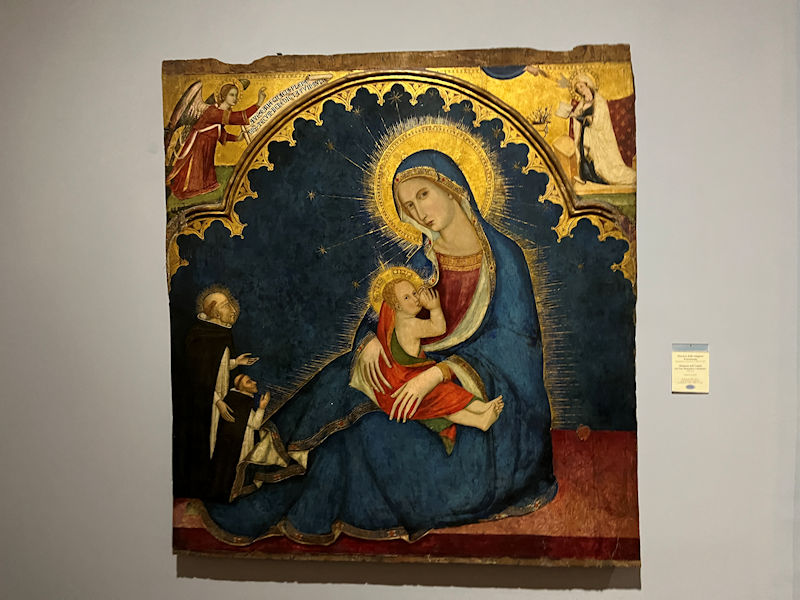
By the 'Maestro delle tempere francescane' [Master of Franciscan tempera'?], this is 'Madonna dell'Umiltà con San Domenico e donatore', 1330-1335 (a big St Dominic and a wee little donor)

Crowded scenes of the stages of Christ's arrest, crucifixion, and resurrection: 'Triptych of the Passion', second half of 15th century, possibly from England.
A close-up of all the parts of that thing on a decent-size screen is amazing.
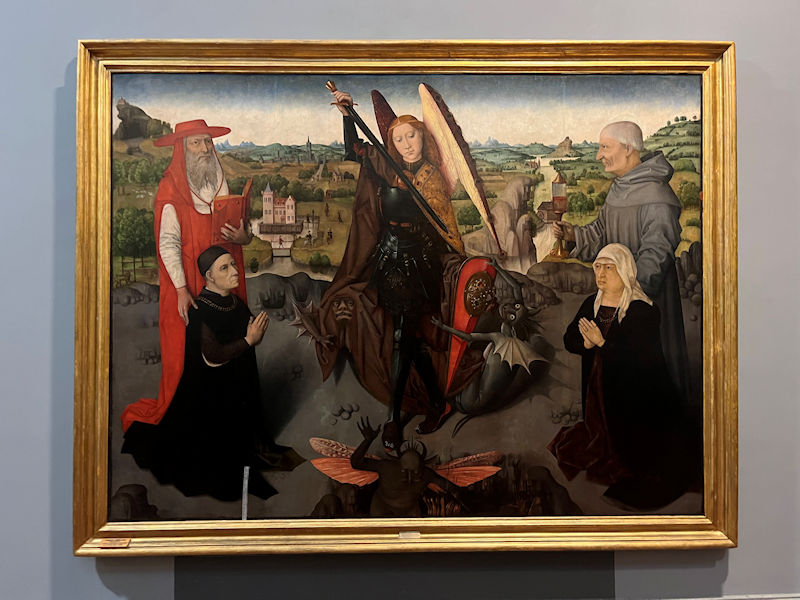
The Archangel Michael slaying the horrible dragon in the presence of four people who don't care at all. They are St Jerome and St James of the Marches and two donors.
St James of the Marches (c.1391-1476), born Dominic Gangala in Ascoli Piceno, was a Franciscan Friar Minor, preacher and Papal Legate and a well-traveled Inquisitor, rooting out heretics and doing miracles (on the plus side, he founded several of the montes pietatis, the nonprofit credit organizations that lent money to the poor as low-rate pawn shops).
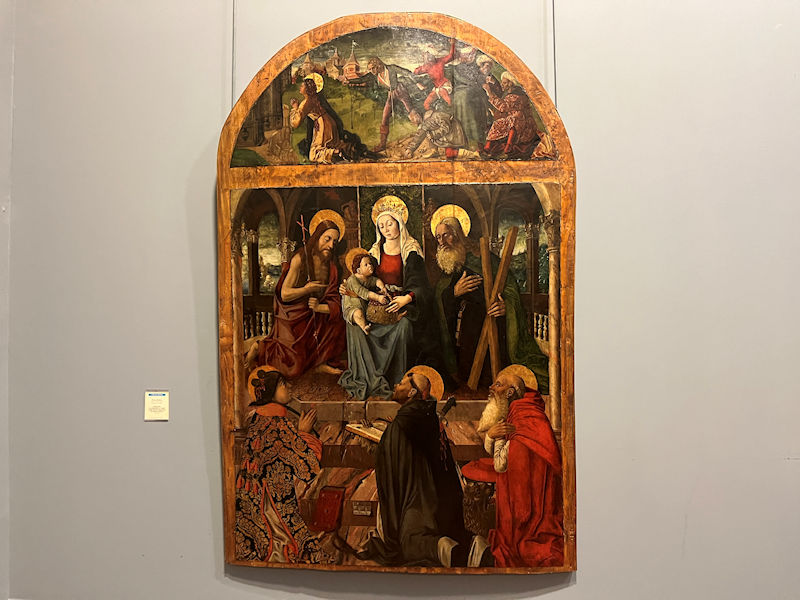
Madonna and Bambino with saints, and with the martyrdom of St Steven in the lunette, by Pietro Befulco, active in Naples 1471-1503
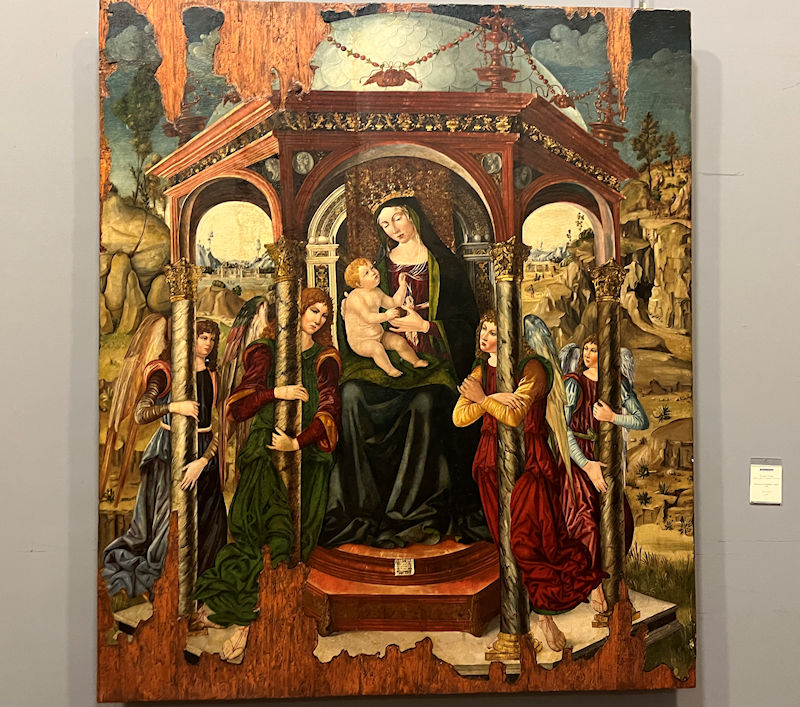
Madonna, Bambino, and angels, 1498, by a Crivelli (not Carlo Crivelli)
from Milan, active in Campania 1497-1506
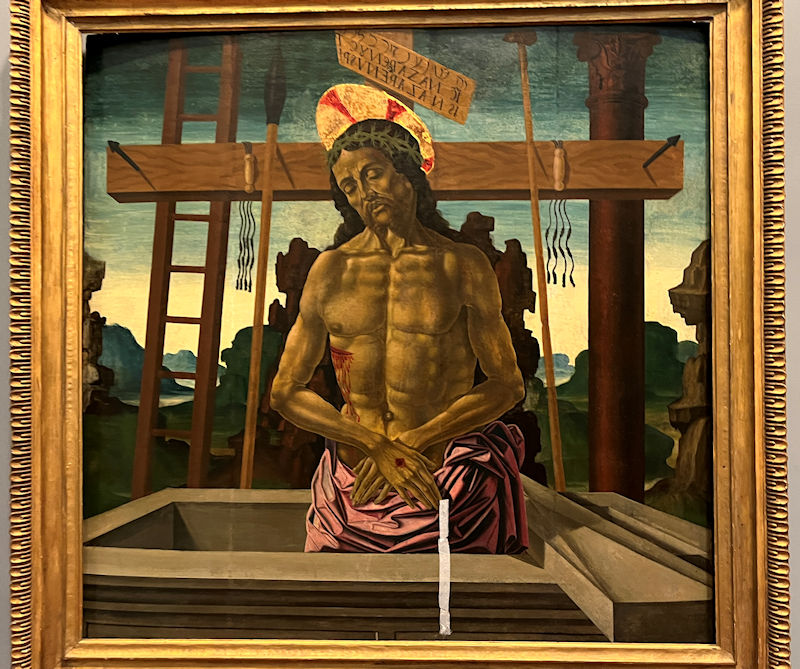
'Christ in the Tomb, with symbols of the Passion', attributed to Vincenzo de Rogata (?), c.1510
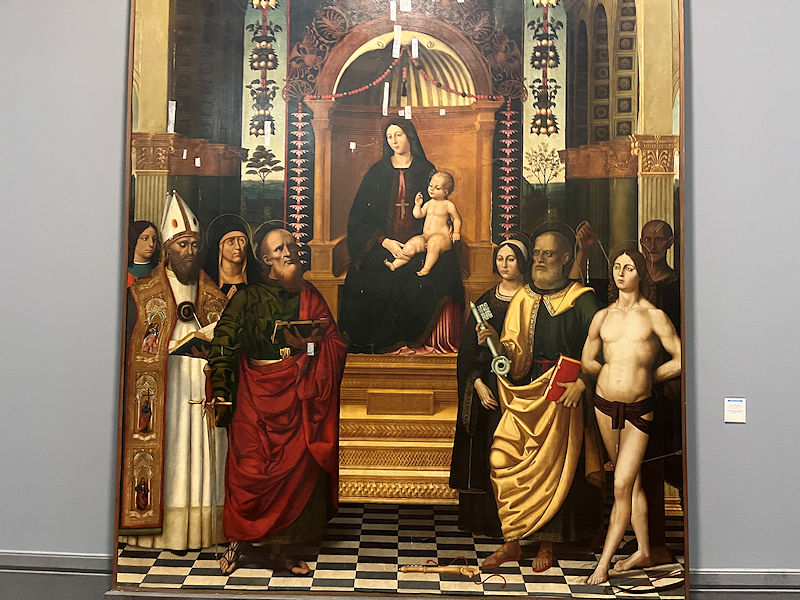
'Madonna with Child Enthroned by Saints', 1509, by Antonio Rimpatta of Bologna
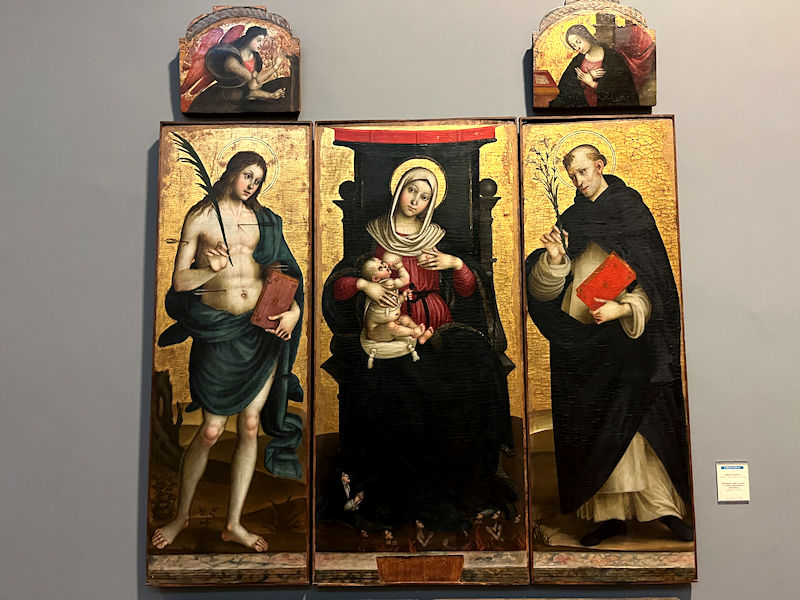
'Our Lady of Graces with Saints Sebastian and Dominic', c.1507, by Stefano Sparano
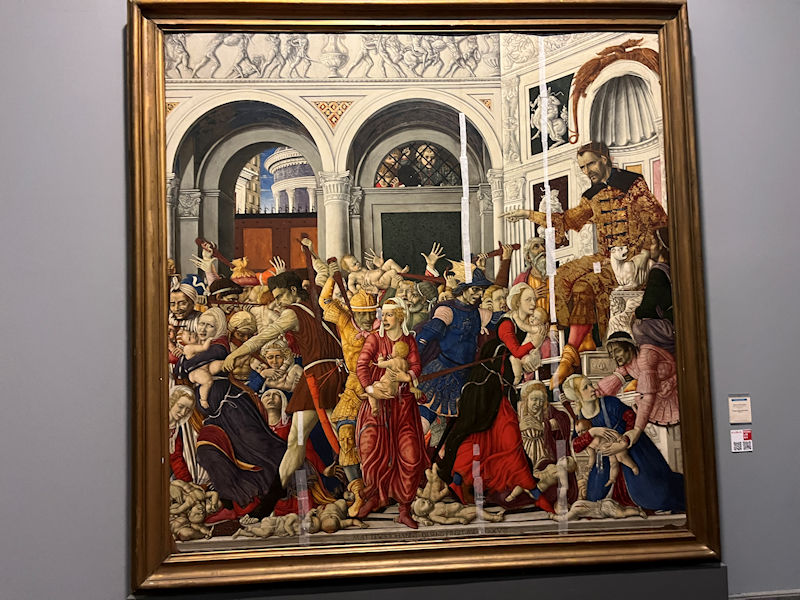
'The Massacre of the Innocents', 1481-1488, by Matteo di Giovanni (c.1430 – 1495) of Siena
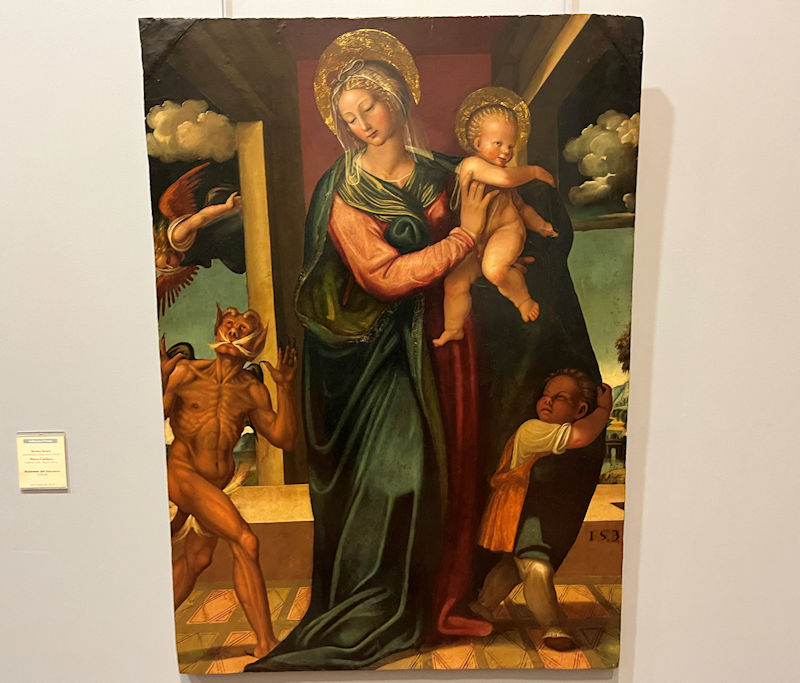
The Madonna del Soccorso, protecting the kids from the nasty demons, 1538-1540, by Severo Ierace and Marco Cardisco of Naples.
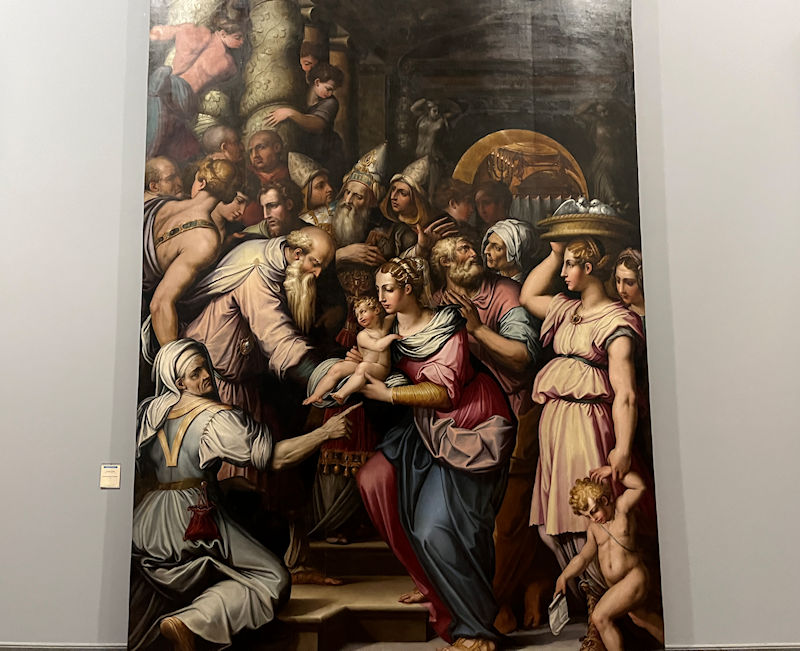
'Presentation of Jesus at the Temple', 1545, by Vasari
[-- Don't crowd! Step back! Give him some air!]
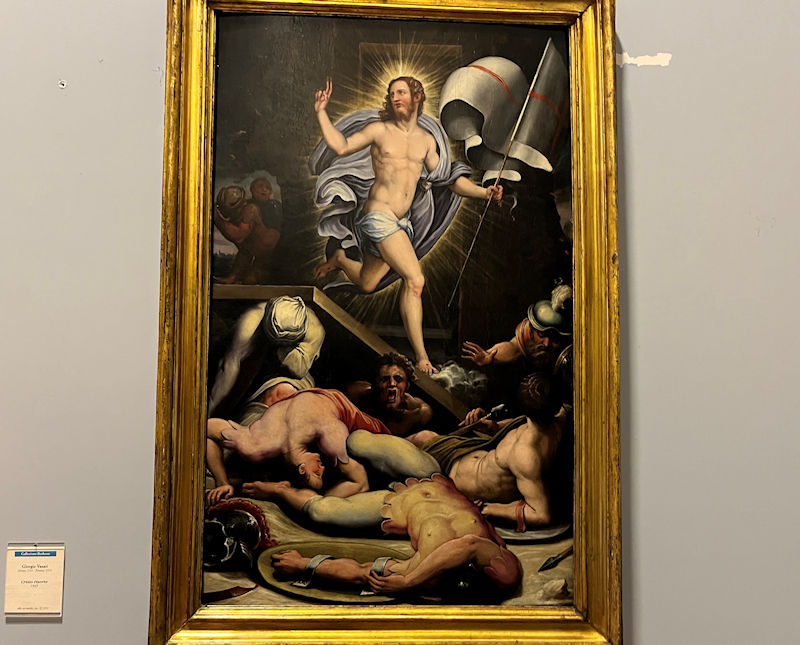
'Cristo risorto', Christ Risen, and a lot of general carnage (collateral damage). Giorgio Vasari, 1545.

'Beheading of Saint John the Baptist', c.1564, by Marco Pino (aka Marco da Siena, 1521-1583)
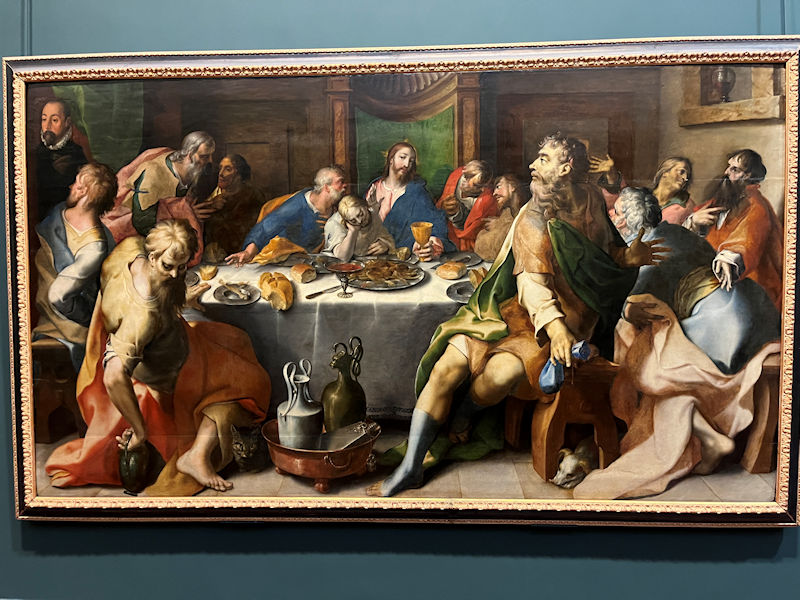
'Ultima cena' or The Last Supper, 1580-1583, by Dirk Hendricksz Centen (1542-1618), born in Amsterdam but working in Naples from 1568 to 1610
One notes that whereas all of the apostles are wearing apparently period costume, the fellow up in the left corner's got a 16th century stuff ruff on. The artist?
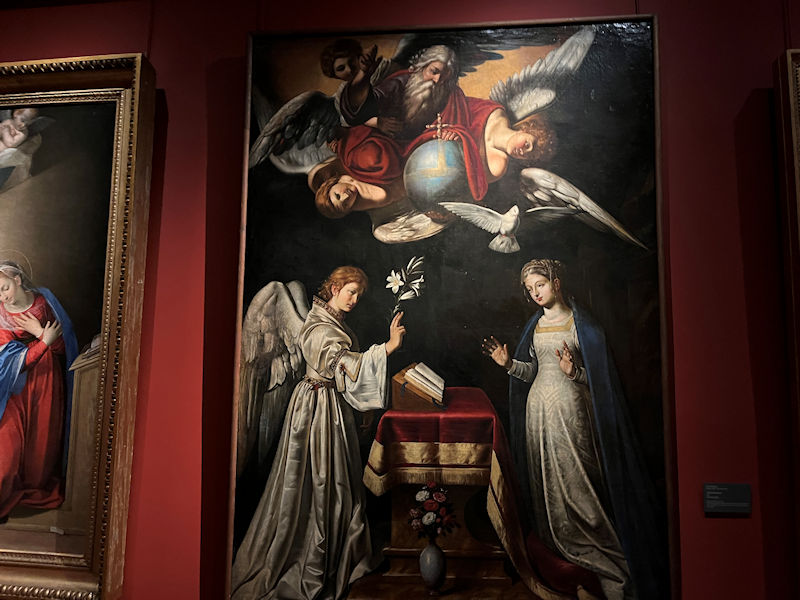
That's a nice Annunciation by Louis Finson, 1612. (God seems to be sort of micromanaging the whole operation?)
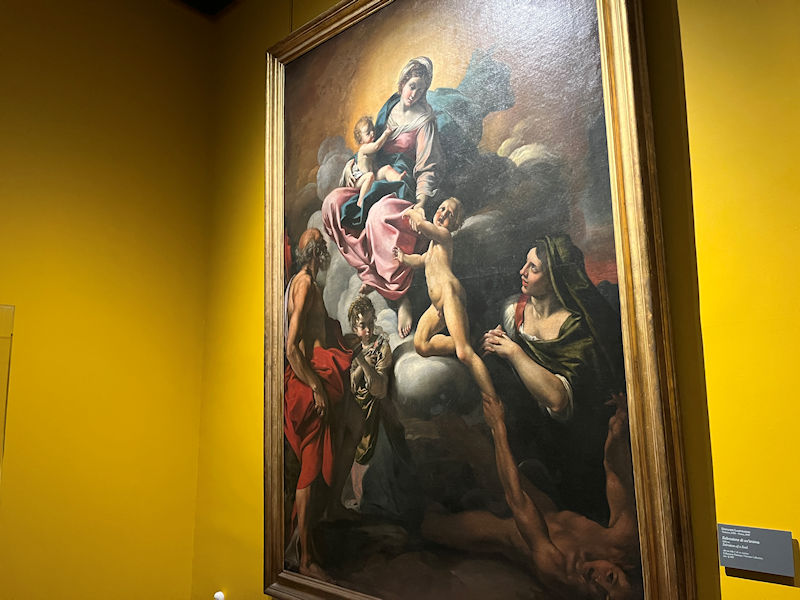
'Salvation of a Soul', c.1613, by Giovanni Lanfranco (1582-1647). Lanfranco was from Parma but as part of the Carracci circle worked mostly in Rome until moving to Naples in 1634, with work here including on the Gesù Nuovo church, the Duomo, and St Martino's monastery on the Vomero hill. He died back in Rome in 1647. (Crowded part of the room, couldn't get a decent angle for the photo.)
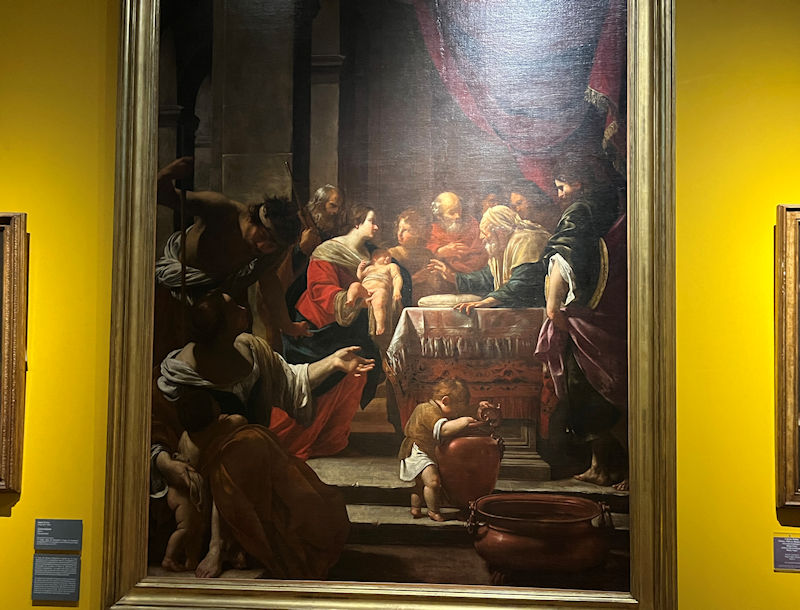
A circumcision scene, c.1620, by Simon Vouet during his long stay in Italy, most in Rome.
We hate circumcision scenes!
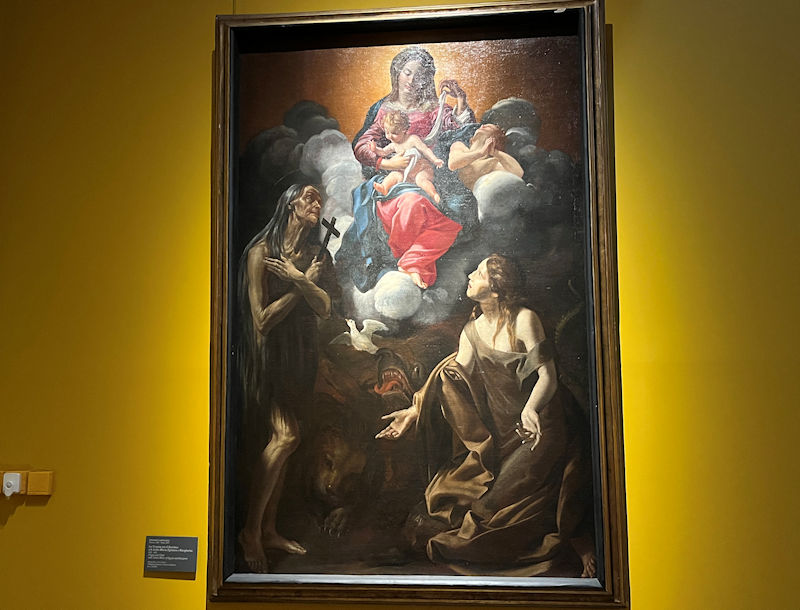
This, also by Lanfranco, is the 'Virgin and Child with Saints Mary of Egypt (left) and Margaret', dated to 1620-1621.
St Mary of Egypt (aka Maria Aegyptiaca) was putatively an Egyptian wild 'grazer saint' who as a nymphomaniac in Alexandria in middle age traveled to Jerusalem to cash in on the Great Feast pilgrims, but when barred by a supernatural force from entering into the church, she repented and, obeying a voice, retired to the Jordanian desert as an ascetic, eating only what she could find in the wilderness. When nearing death, she was living naked and almost unrecognizable as human but told her story to Zosimas of Palestine. Various cults' estimates of the date of her death are wildly different. Her relics (including a bit of her right foot) are scattered all over Europe and in some eastern Orthodox churches in the USA. Respighi wrote an opera about her in 1932. She is known only by a hagiography by Sophronius, Patriarch of Jerusalem, in the mid-630s.
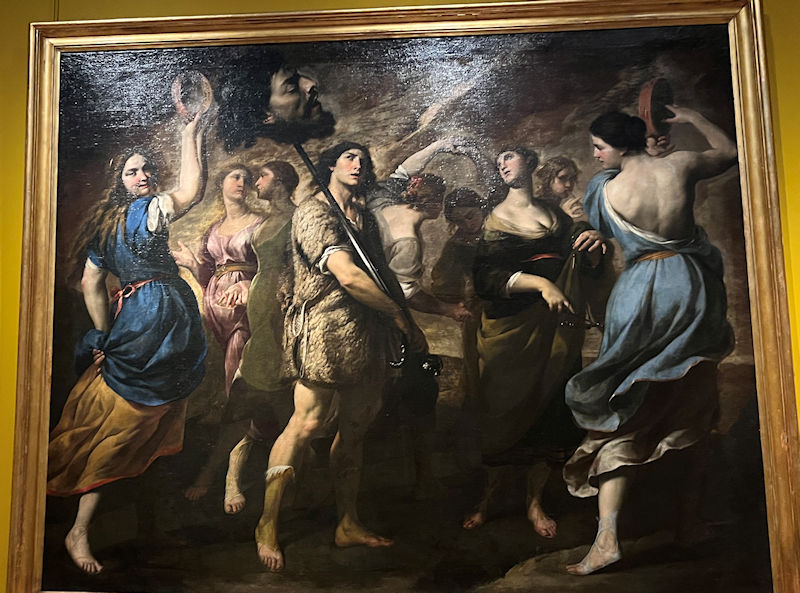
-- David, get that thing out of here. This isn't that kind of a party!
(The 'Triumph of David', c.1650-1655, by Andrea Vaccaro)
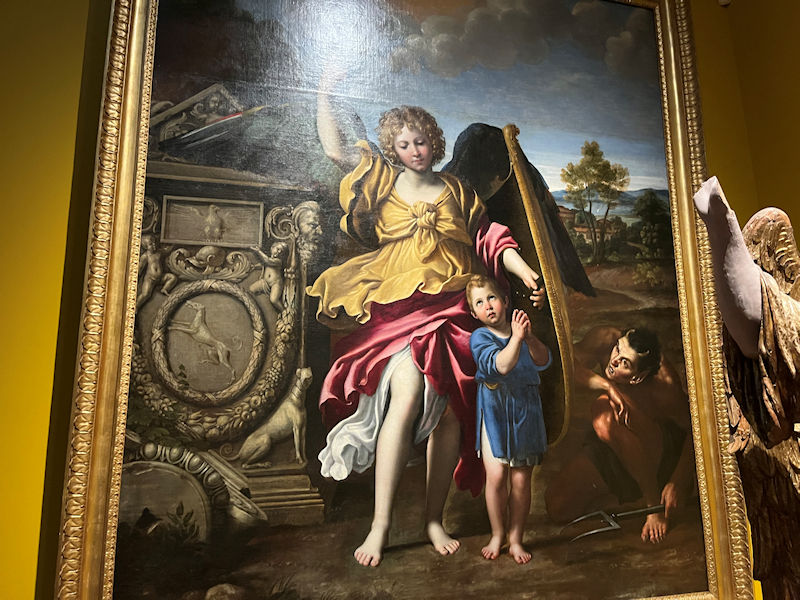
'Angelo custode', The Guardian Angel, 1615, by Domenichino (1581-1641), one of the Bolognese painters who'd come to Rome to work but moved to Naples in 1631 to spend the rest of his life on the 'Scenes from St Gennaro's Life' in the Treasury Chapel of the Duomo.
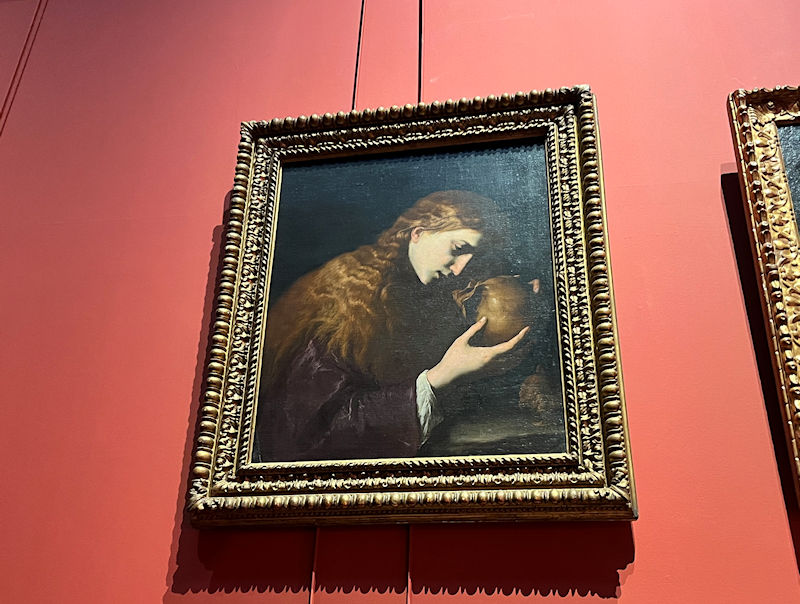
'Maddalena in meditazione', c.1620, by Jusepe de Ribera (1591-1652), born in Spain but working in Rome ca. 1613-1616 and then in Naples (then under Spanish rule) for the rest of his life.

'The Capture of Christ', 1632-1635, by Matthias Stom or Stomer (c.1600-post 1652), Dutch or Flemish, who trained with the Utrecht Caravaggists before arriving in Rome at least by 1630; he was in Naples from 1635 to 1640, then in Sicily from 1641 to 1649. The time and place of his death are unknown, and there are no known works of his besides those he made in Italy.
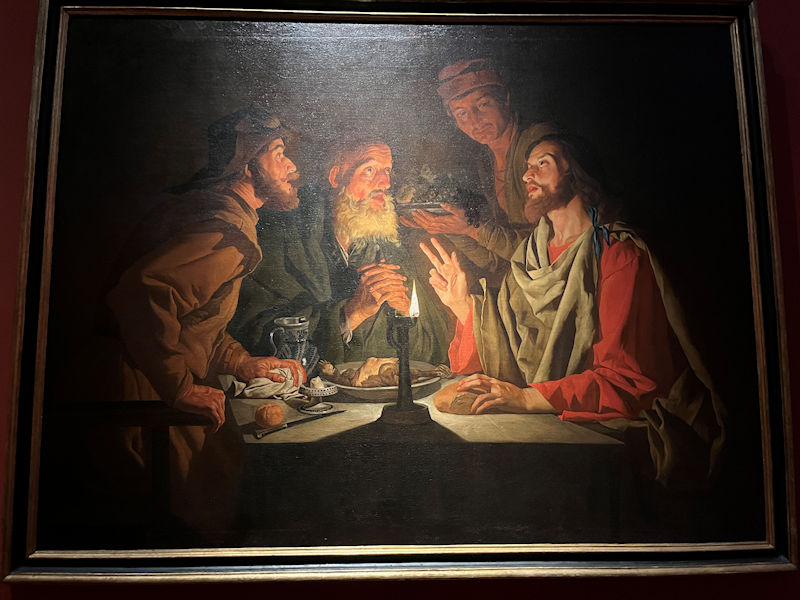
'Supper at Emmaus', also by Matthias Stom
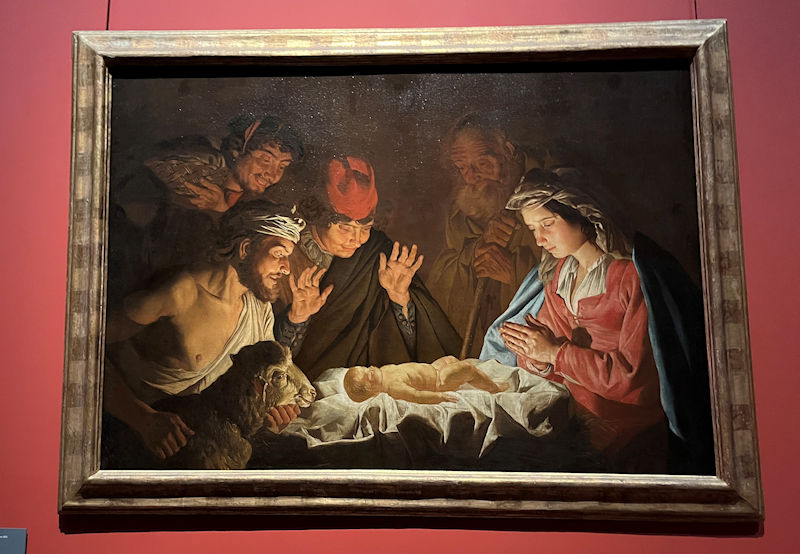
'Adoration of the Shepherds', also Matthia Stom
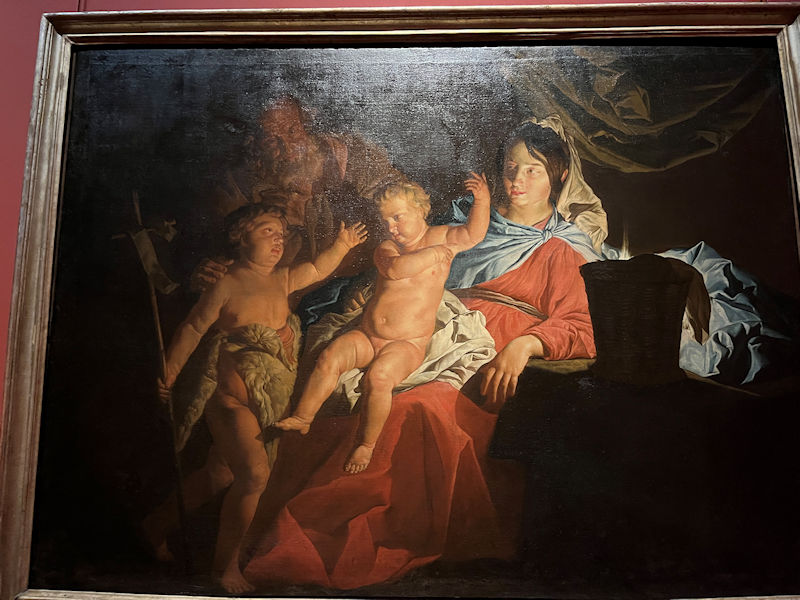
'The Holy Family', Sacra famiglia, 1632-1635, another by Matthias Stom or Stomer
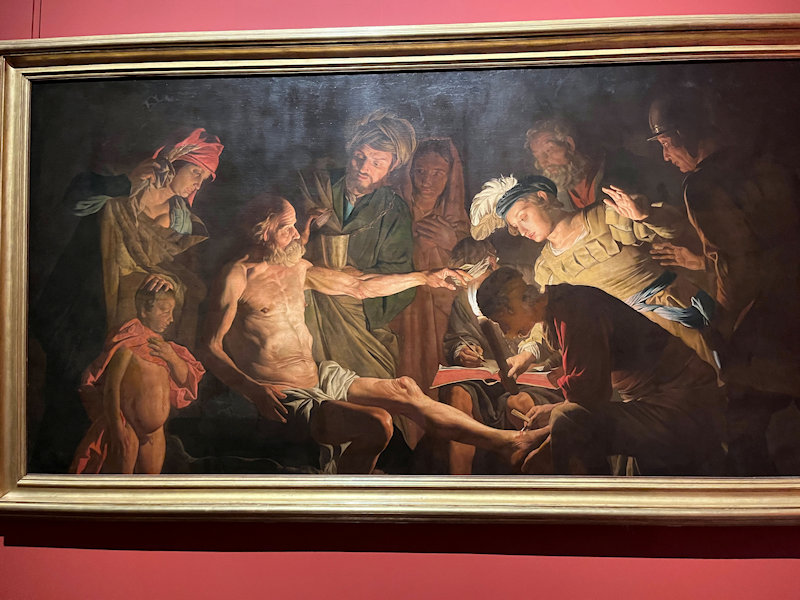
'The Death of Seneca', 1638-1640, Matthias Stom. The tragedian Seneca was implicated in a conspiracy against Nero, though probably innocent, and was ordered by the emperor to kill himself. The traditional dignified way to do that, we're told, was to sever several veins and bleed to death, which here he is doing whilst dictating his last speech.
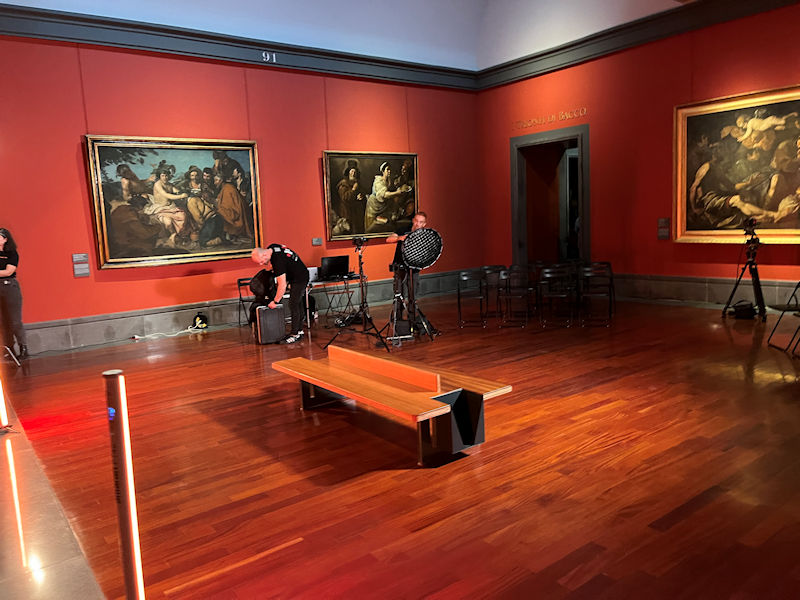
These folks are packing up their gear after having filmed some sort of interview or lecture.
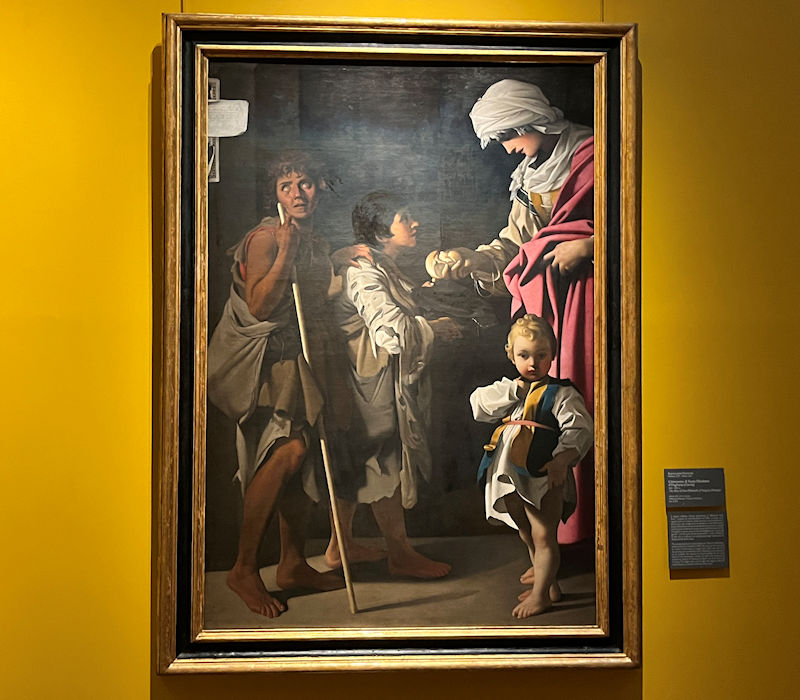
This is an interesting work by Bartolomeo Schedoni (1578-1615), 'L'elemosina di Santa Elisabetta d'Ungheria' -- 'The Alms of St Elizabeth of Hungary (Charity)' -- dated to c.1610. The saint is handing out bread to the poor and blind, and this scene is said to occur just before she was discovered by her angry husband but transformed the bread into roses to show that God had been intervening.
No word about whether they could eat the roses instead.
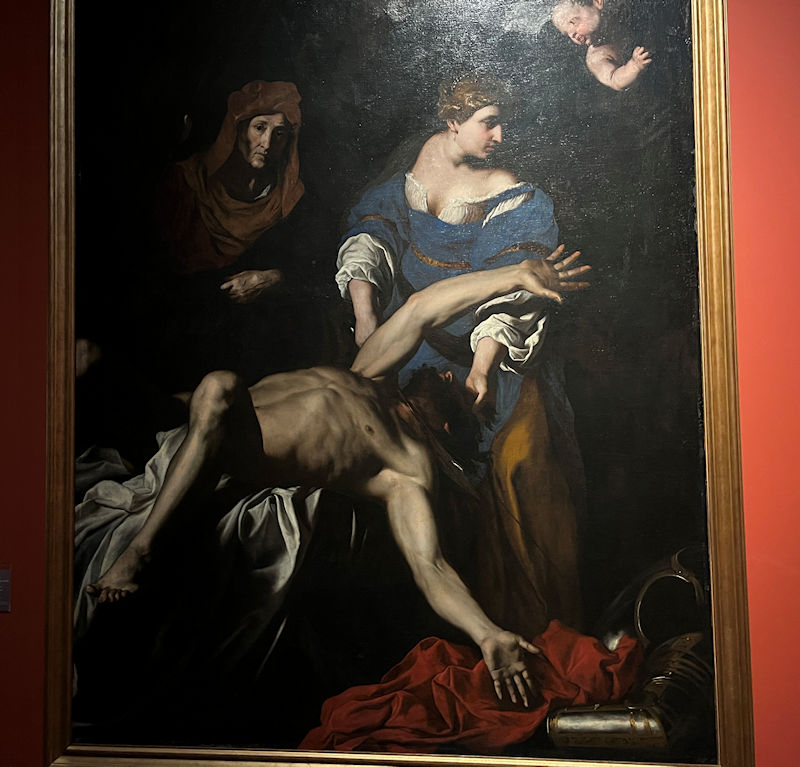
One does relish a good 'Judith decapitating Holofernes' (a fad, we've been told, that may have been inspired by the execution of Beatrice Cenci in 1599), and this one is not bad, except for the unconcerned look on the nurse's face and the baby inexplicably hanging from the ceiling (who's actually a cherub or something who's been cropped off the photo). It's by Pietro Novelli in 1637.
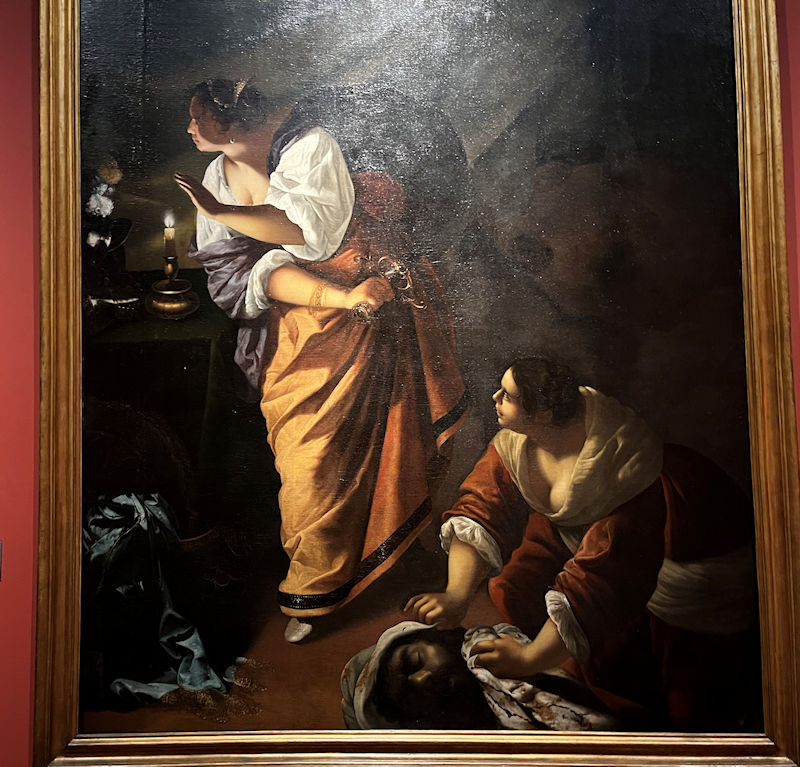
'Judith and her Maid Abra with the head of Holofernes', 1645-1650, by Artemisia Gentileschi
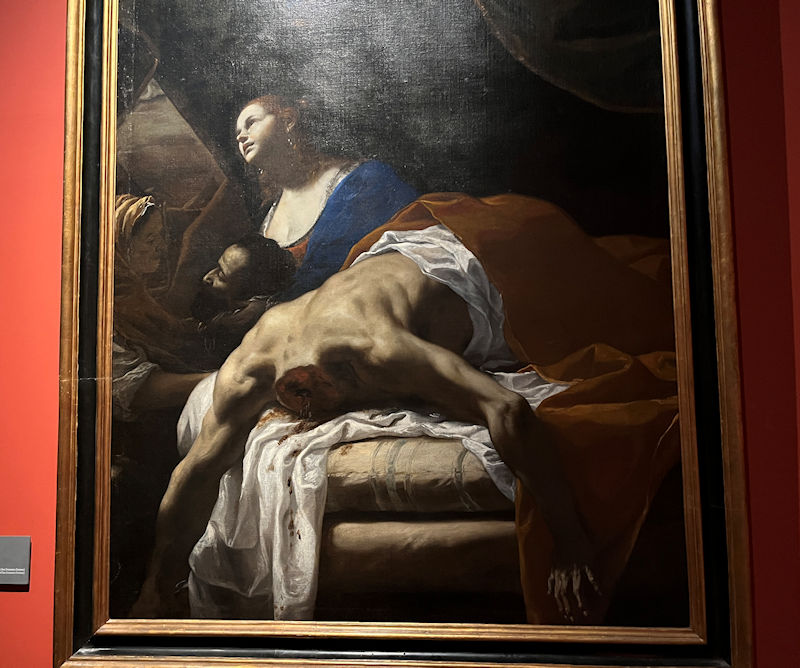
And still another 'Giuditta e Oloferne', dated to 1653-1659, by Mattia Preti, who evidently worked for most of his life in Naples.
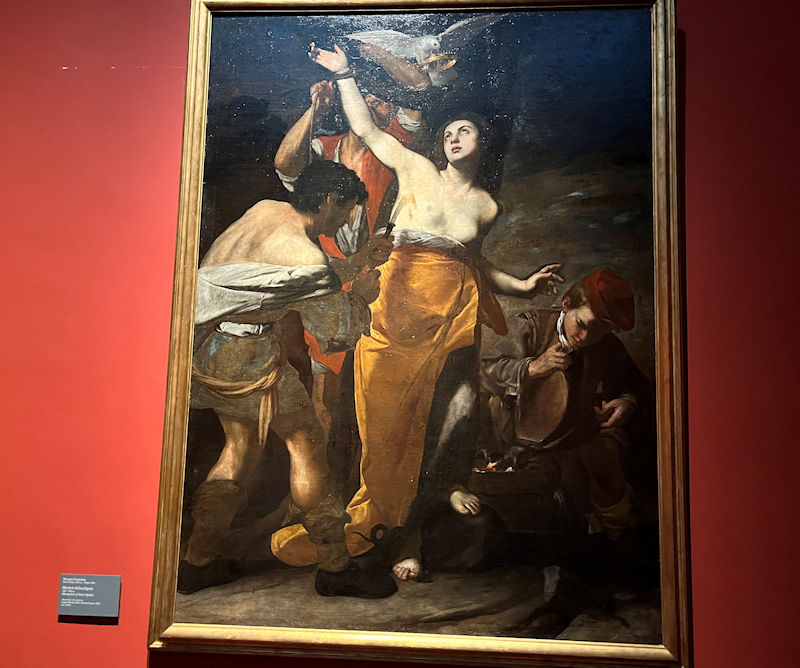
The grim 'Martyrdom of St Agatha' with that half-shirted mastectomist setting about his work (credited to Massimo Stanzione of Naples, dated to 1618-1620).
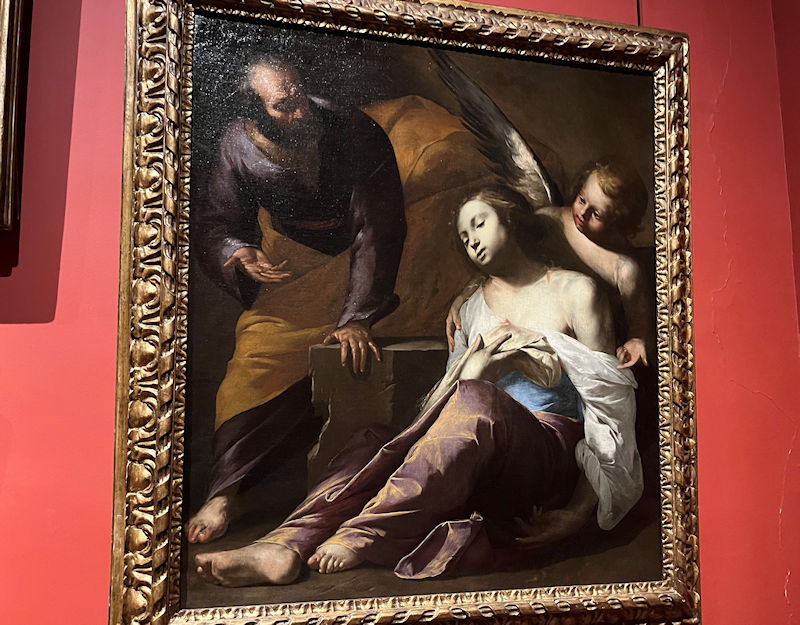
It's okay, though, because St Peter visited Agatha in prison and cured her ailings at that time (though she was martyred anyway). This is attributed to the Neapolitan Antonio de Bellis, active in Naples 1630-1660.
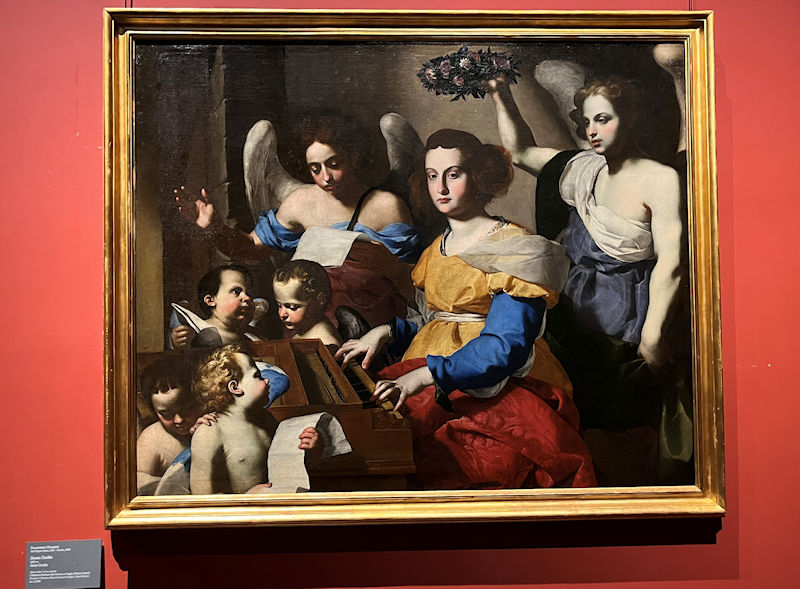
There's St Cecilia the musicians' friend, hammering away at the ivories, whilst a bunch of cherubs and angels try to follow along. Dated c.1645, by Francesco Guarino (1611-1654). She evidently plays the spinnet with a monumental passion.
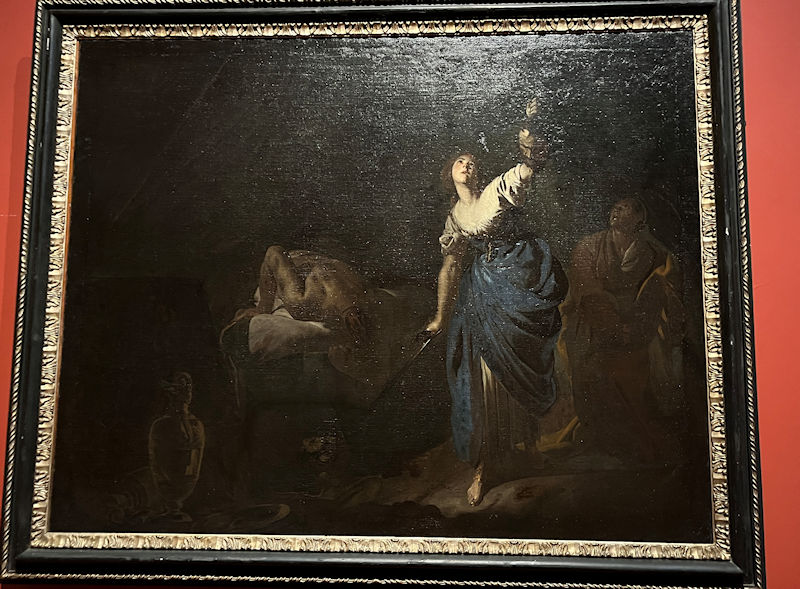
Great, another Judith and Holofernes, this by Bernardo Cavallino (Naples 1616-c.1656), dated to c.1645.

And still another Massacre of the Innocents, 1650-1655, by Micco Spadaro (Domenico Gargiulo, 1609-1675)
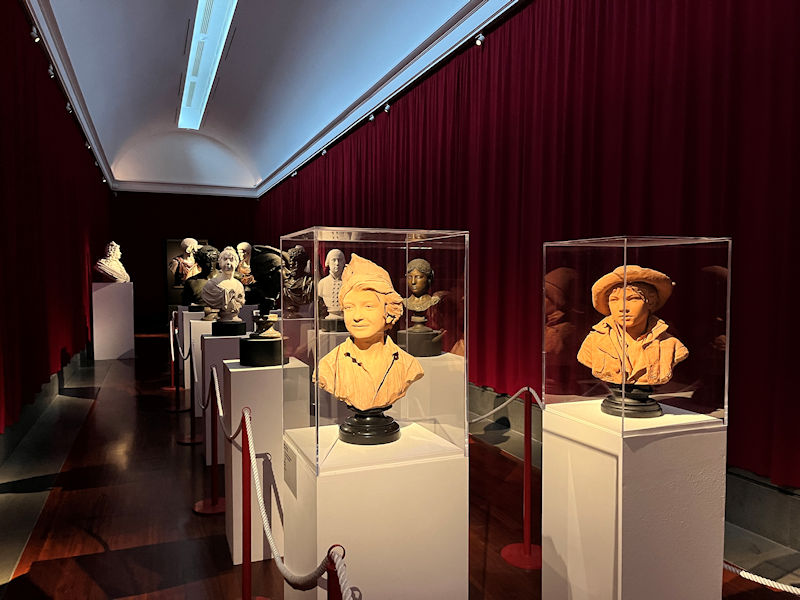
A roomful of heads
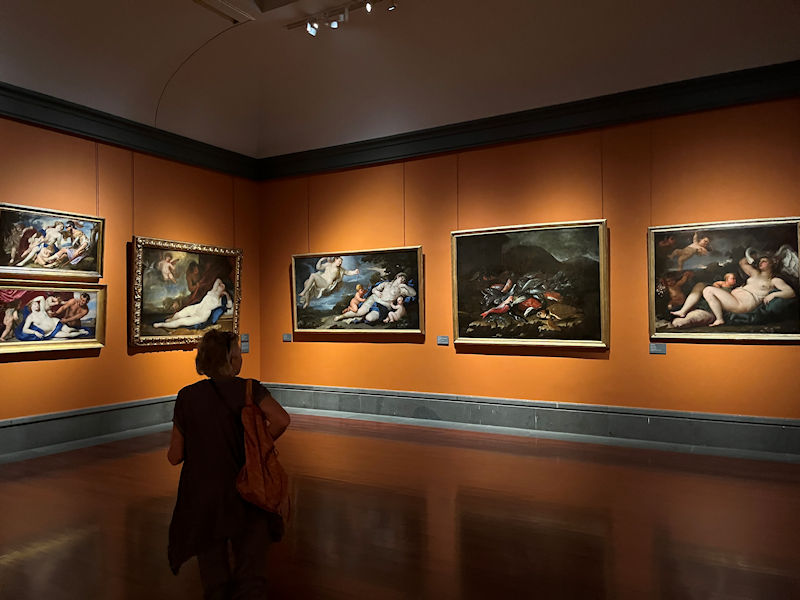
A lot to take in at one time.
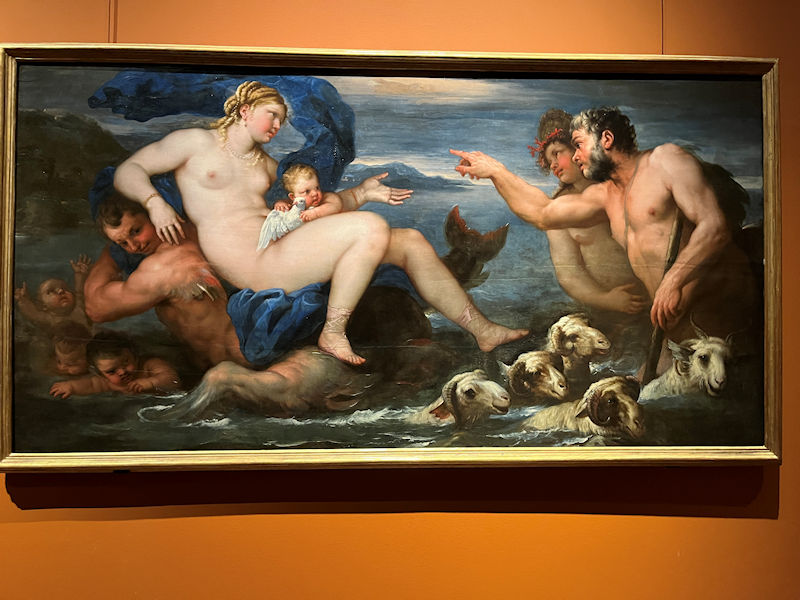
-- Don't tell me that, I know when you're lying.
A goofy rendition of some myth, with sheep swimming around and little kids hiding out or playing with a dove. It's 'Polyphemus and Galatea', c.1674, by Luca Giordano (1634-1705), a preeminent artist in the Neapolitan firmament. This Galatea was a Nereid sea-nymph pursued by the one-eyed giant Polyphemus, as described by Theocritus, Ovid, and Virgil amongst others.

The works are progressing very well, it seems.
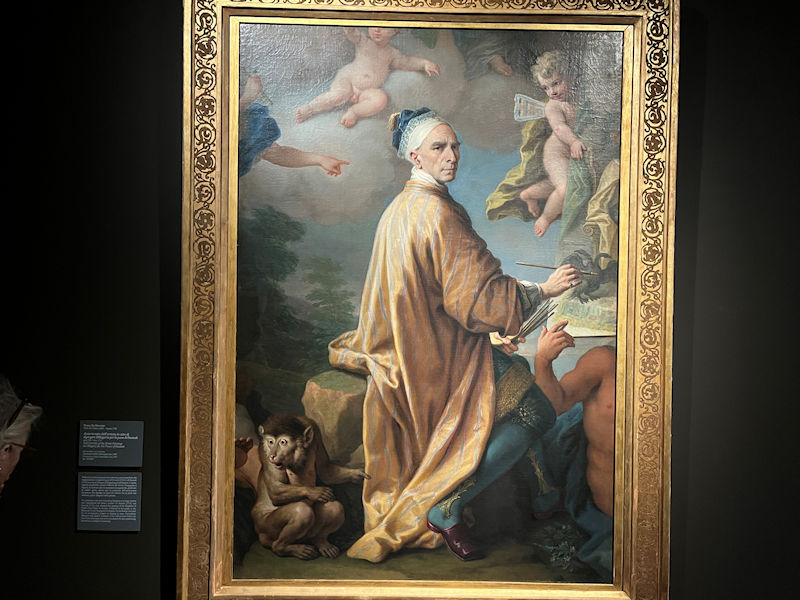
This guy, Paolo de Matteis (1662-1728), is hilarious; this is his 'Self-portrait of the artist painting an allegory for the Peace of Rastadt', c.1714. He was apparently heavily criticized at the exhibitions for offensive iconography . . .
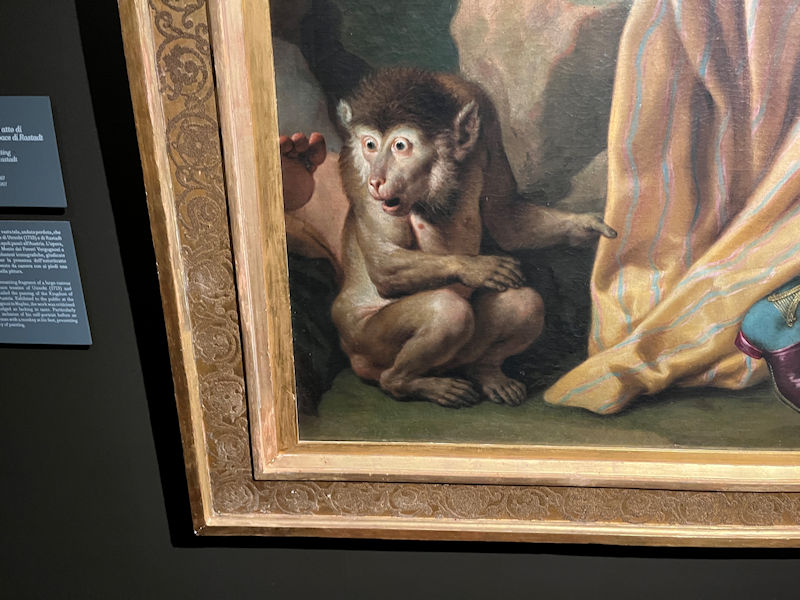
. . . especially the monkey, of course, but perhaps also having little cherubs hanging out round his easel.
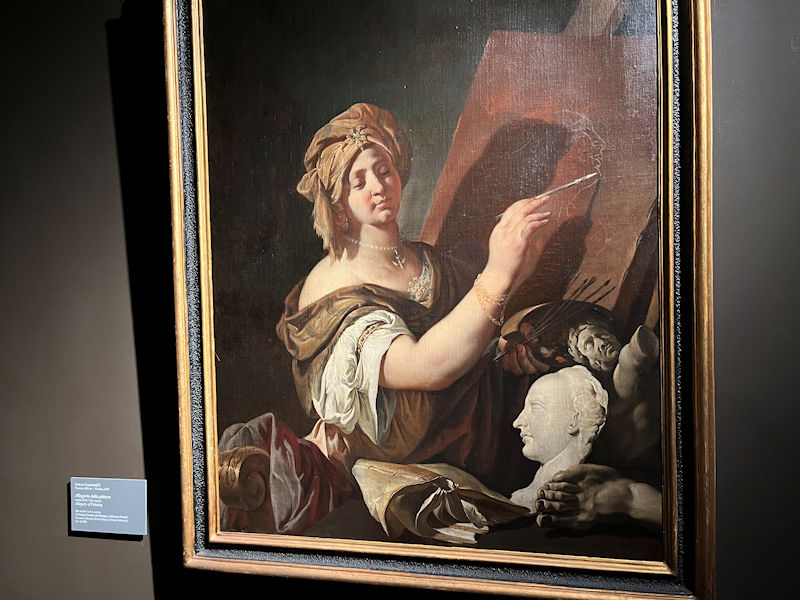
Another 'Allegory of Painting', tentatively attributed to Giulio Carpioni, no date.

The English title included here is 'The Temptation of Christ on the Mountain', but a translation of the original title in Italian would be 'Christ drives out Satan who falls from a mountain', which is more fun. It's by Mattia Preti in about 1656.
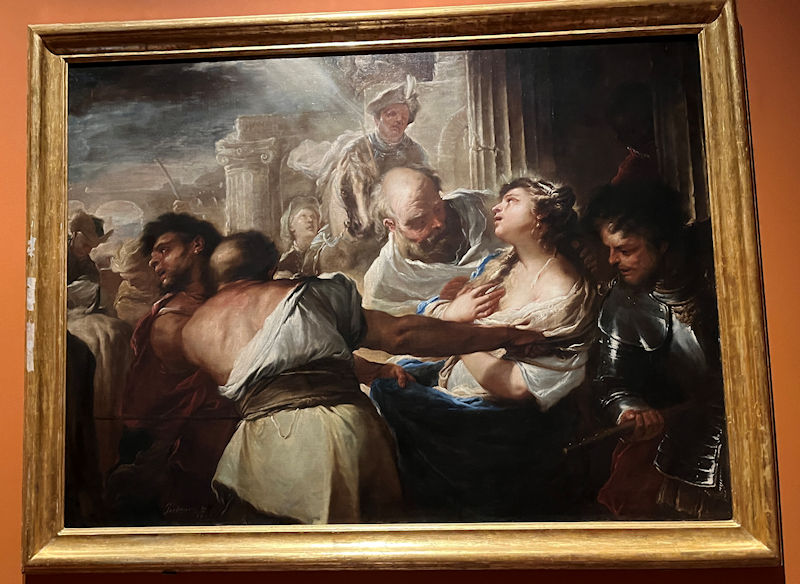
Luca Giordano's 'Santa Lucia being led to her martyrdom', 1659.

The Babylonian king Balthazar, 6th century BC, hosts a big feast using golden cups and plates stolen from the Temple of Jerusalem. Only Daniel can interpret the prophetic words being written on the wall. Mattia Preti's 'Convito di Baldassarre', c.1668, captures the moment.
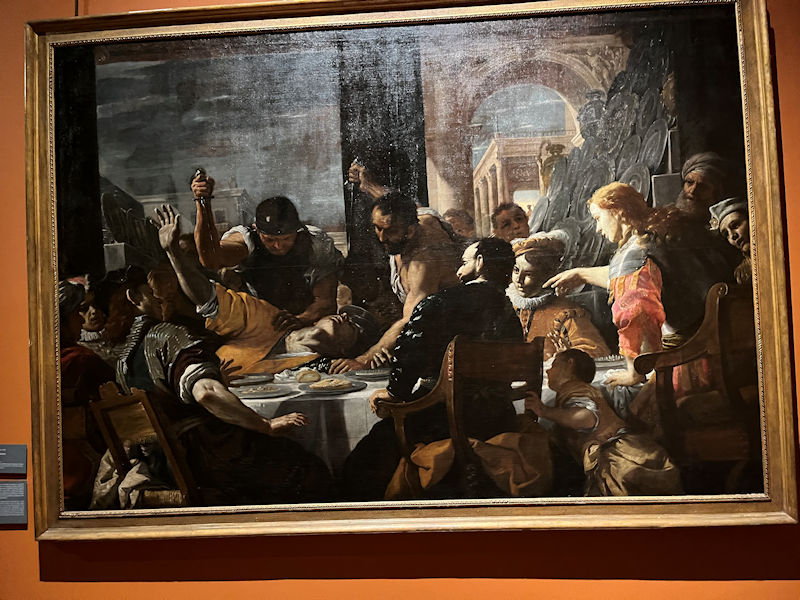
Continuing the theme, Preti interrupts the 'Feast of Absalom' with Absalom ordering the assassins to murder his rapist half-brother. Very dramatic scene, dated to about 1668.
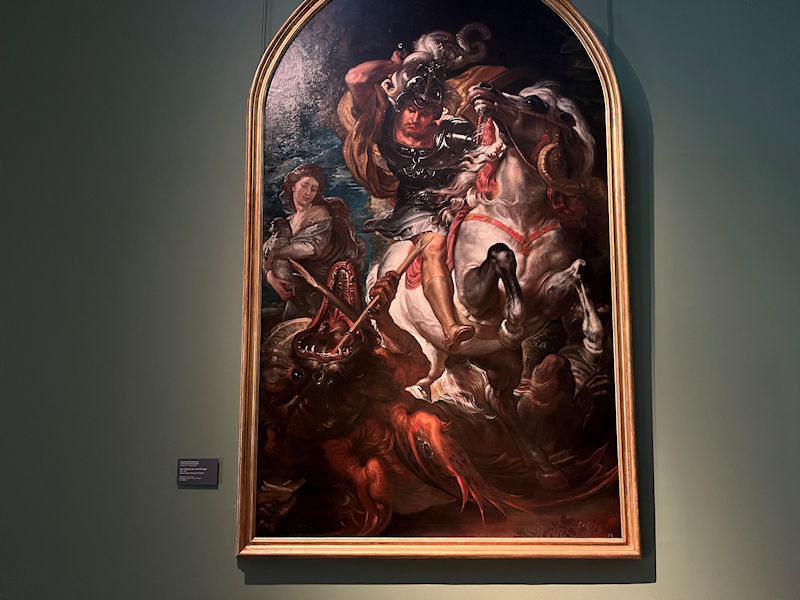
St George slaying his dragon, c.1601, is described here as 'After Peter Paul Rubens'. Which means what?

'Perseus and Medusa', after 1660, by Luca Giordano
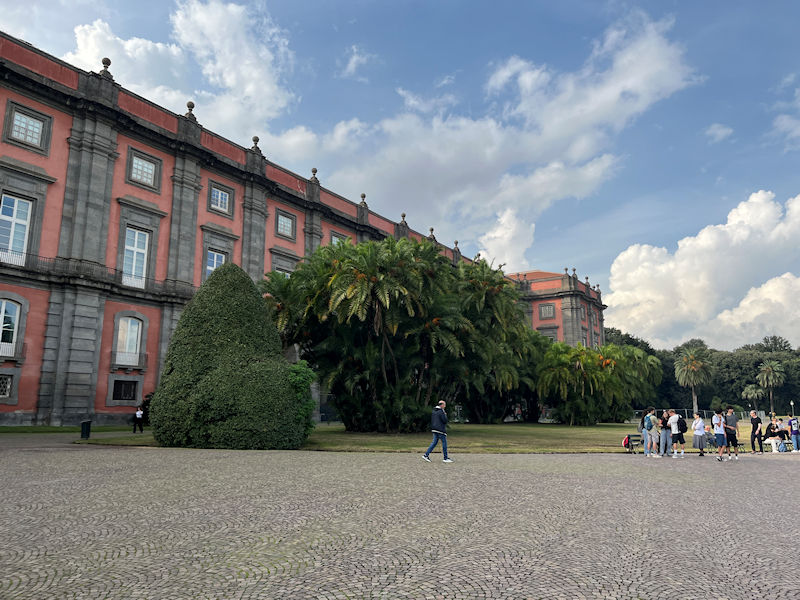
And on that note, we'll start back down to the city, wondering . . .
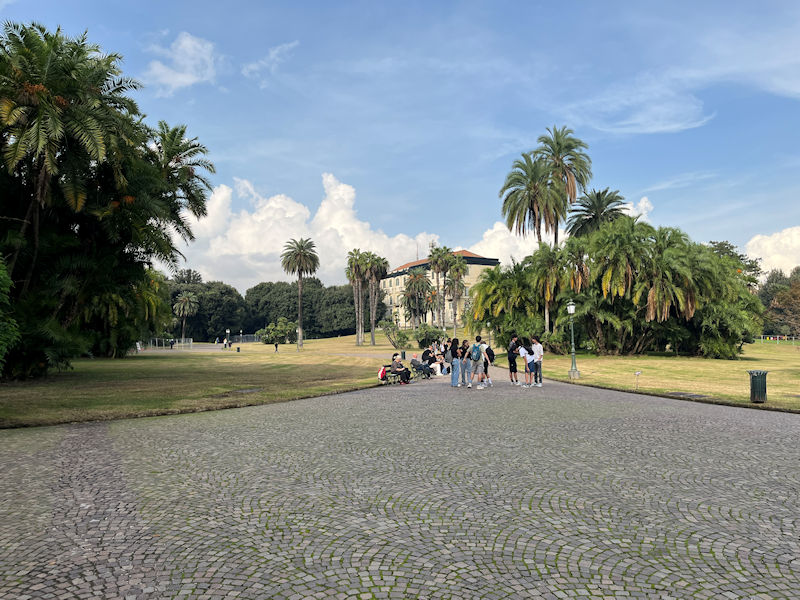
. . . about what percentage of the goods we got at least a glance at.
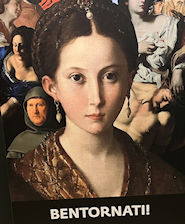 Dwight Peck's personal website
Dwight Peck's personal website






















































